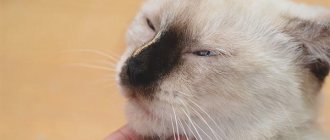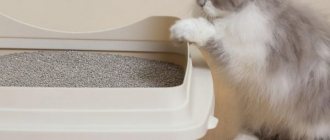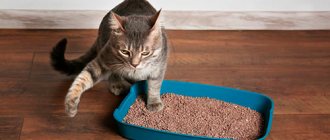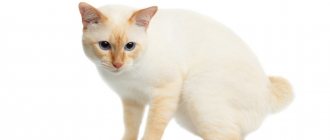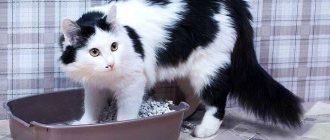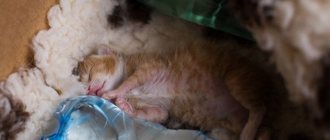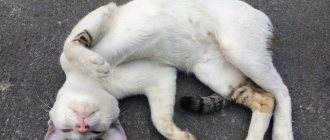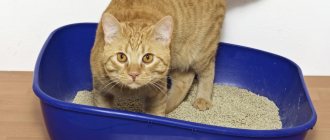Your cat spends a long time in the litter box without excreting anything other than a few drops of urine. Why can't my cat pee? What's wrong and will it get better on its own? They may have had cystitis in the past, but is it a recurrence? The cause may be a bladder blockage, and this is a real cat emergency.
Let me start by saying that if at this very minute you have a cat who is currently struggling or straining to pee and if he is showing any form of discomfort, pain or distress or in any way If you are not healthy, you should stop reading and contact your veterinarian immediately. If left untreated, bladder obstruction kills quickly and requires prompt treatment. Don't read to the end, call your veterinarian. Jokes aside.
How much should a cat urinate normally?
Before moving on to the description of deviations, it is important to mention the recommended standards. Changes in the usual volume of urine and the frequency of trips to the toilet will tell you about the pathology.
Volumes
The exact indicator is determined individually based on the following factors:
- Type of food.
When feeding “natural” food, the body receives not only clean water, but also liquids from foods. This is reflected in the volume of allocations.
- Weight.
Obese animals have less bladder control, so their litter box needs to be changed frequently.
- Age.
Unlike an adult, a kitten is simply not able to make a puddle that is too large due to its size.
- Floor.
During pregnancy, a cat pees more than a cat due to constant pressure on the uterus.
On average, the volume of liquid coming out is 50-200 ml. It can be measured with a measuring cup, after removing all the filler from the tray in advance.
Frequency
Before puberty, kittens pee up to 5 times a day. With age, the frequency of urination decreases by 1-3 times.
The number of trips to the toilet periodically increases during estrus and pregnancy - or remains at the kitten level after castration. In the absence of other alarming symptoms, both phenomena are completely normal.
FAQ
After ejaculation I want to pee, but I can’t. This is fine?
— During an erection, it is normally difficult to urinate. If the erection has passed, but it is still difficult to urinate, it is worth dealing with this in person.
Over the past two years, a not very pleasant problem has appeared. Two or three times during this period, before menstruation there is urinary retention and obvious swelling under the eyes. With menstruation, a lot of fluid is released. What needs to be examined and what is the reason?
- This is how premenstrual syndrome manifests itself. If these symptoms cause concern, then you can take diuretics on such days.
Ask a Question
What symptoms should you be wary of?
In addition to urinary retention itself, accompanying symptoms can indicate the presence of a problem. These include:
- apathy and depression;
- severe thirst, deterioration or loss of appetite;
- abdominal growth not associated with obesity or pregnancy;
- increased body temperature;
- sleep disturbance;
- swelling of the paws and neck;
- vomiting and diarrhea;
- bending of the hind legs, their uncharacteristic stretching or the appearance of convulsions.
If you notice at least a few of the listed symptoms, you should contact your veterinarian. Otherwise, the cat risks dying from intoxication with decay products.
Prevention measures
In order to prevent the development of a pathological condition, it is necessary to adhere to some rules:
- Provide the cat with sufficient drinking regime.
- Organize proper nutrition with sufficient fiber intake.
- Treat concomitant diseases of the intestines and genitourinary system in a timely manner.
- Vaccinate and deworm your pet.
- Avoid physical inactivity, play with your pet more often, and take walks.
In addition, you should carefully monitor the cat’s condition and contact a veterinarian at the slightest sign of pathology.
How to understand that an animal has urinary retention
Urinary dysfunction is very easy to diagnose yourself. Due to an overcrowded bladder, the cat experiences severe pain, and the urine itself changes its color and consistency.
Main symptoms include:
- aggression when palpating the abdomen;
- reducing the volume of urine and increasing the frequency of trips to the toilet;
- leaving puddles or small droplets outside the tray (due to pain, the cat avoids the tray and sits down to relieve itself throughout the house);
- frequent licking of the genitals;
- the appearance of mucus, pus or blood in the urine, as well as a change in its odor.
There is no point in scolding your pet at this time. Your negative reaction will only worsen his condition due to stress. The former cleanliness will return immediately after recovery, so just concentrate on eliminating the problem.
What disorders cause difficulty urinating?
Depending on the existing disorder, urine is completely or partially absent - or it encounters an obstruction at the exit. In the first case, the cause usually lies in renal pathologies, and in the second, in blockage of the urethra due to excitement, trauma, infections and stones.
Sexual arousal
Most often, during sexual hunting, owners complain about the opposite problem - frequent urination in females and leaving marks in males. But excitement also leads to enlargement of the gonads with subsequent compression of the urethra.
Injuries
After an accident and falling from a height, a cat can damage its internal organs. In this case, the delay is explained by the loss of their functionality, and the presence of blood in the urine is due to internal bleeding.
Cystitis and other bladder diseases
The most common reason why a cat cannot pee is cystitis. Inflammation in the bladder is usually caused by bacteria that enter there directly or from neighboring organs. The pathology is accompanied by severe pain, increased urge and a gradual reduction in the volume of fluid to a few drops.
Advanced cystitis is often complicated by urethritis. With this disorder, the inflammatory process covers the urethra. It can be diagnosed by purulent discharge and a strong odor of acetone or ammonia from the pet's skin.
Urolithiasis disease
When there are too many stones in the ureter, a blockage occurs. Every attempt to urinate is accompanied by acute pain due to stones that injure the delicate mucous membrane. The blood emerging from numerous wounds turns the urine pink or comes out in separate clots.
“
Read more about urolithiasis in cats
Renal pathologies
Of all the kidney diseases in cats, kidney failure is the most common. It occurs when there is blockage and compression of the urinary tract, a sharp decrease in the amount of blood circulating through the kidneys, and direct dysfunction of the organ. The last case has the most unfavorable prognosis, since damaged kidney cells are not able to recover.
Causes of feline megacolon
Behavior and lifestyle
- Foreign material (swallowed bones, swallowed hair)
- Excess fiber in the diet
- Lack of exercise
- Stress (the problem of having several cats, change of environment, hospitalization, moving, dirty litter box)
- Intestinal obstruction
Pain
- Trauma, joint disease, pain as a symptom of disease
Dehydration (insufficient water intake)
And although cats are desert animals by nature, their modern relatives need free access to water for the normal functioning of all body systems. And if for some reason there is a violation of the hydrobalance (for example, with kidney disease), then the water necessary for the formation of feces begins to be absorbed in the colon, as a result of which they form hard and dry.
Metabolic disorders
- Obesity
- Low blood calcium levels
- High levels of parathyroid hormone (important for calcium absorption)
- Low blood potassium levels
- Low levels of thyroid hormone in the blood
Neurological problems
- Paralysis/muscle weakness (intestinal muscles cannot move feces)
Colon obstruction
- Pelvic deformities (eg, healed pelvic fracture after injury)
- Tumor
Idiopathic megacolon
Megacolon can also occur in a cat as a primary condition without an obvious underlying cause. In this disease, a problem develops in the muscles of the colon wall itself, resulting in a progressive inability to contract.
First aid: what to do if the cat cannot pee?
Veterinarians recommend not to self-medicate and seek help immediately. Otherwise, there is a risk of worsening the condition due to incorrect selection of the drug and its dosage.
You can provide first aid only when you are unable to deliver your cat to a veterinary clinic in the near future. But even in this case, you need to contact the doctor at least by phone in order to receive detailed instructions from him.
Acceptable Actions
If you do not have sufficient experience in palpation and massage, then it is better to avoid these actions. Too much squeezing can cause injury to the mucous membrane and even rupture of the bladder.
A cat showing signs of thirst can be given some water from a dropper or light chicken broth. But you shouldn’t force drink. In case of renal failure, this will increase swelling and create additional stress on the overcrowded organ.
“ Kind words and not too active games will contribute to a temporary improvement in the condition. They will help distract you and reduce accompanying symptoms.
On the recommendation of a doctor, you can give an antispasmodic or pain reliever. They will help eliminate urethral spasm and pain.
Prohibited actions
If your cat has problems with urination, then under no circumstances use warming compresses. In case of intoxication, additional heat will only accelerate the spread of infection.
It is also prohibited to give medications without first obtaining advice. Antispasmodics increase bleeding, and diuretics increase the volume of internal fluid. To prescribe them, it is necessary to know the exact or at least presumptive diagnosis made by a veterinarian.
Diagnostics in a veterinary clinic
Urinary retention and its cause are determined on the basis of palpation, ultrasound and x-ray of a congested organ. In addition to bladder enlargement, these tests help diagnose kidney problems, tumors and stones.
Additionally, blood and urine tests are taken from the mustachioed patient. With their help, the causative agent of infection, the type of stones and the level of intoxication of the body are identified.
Forecast
Modern technologies and advanced techniques used in our clinic guarantee favorable prognoses in the vast majority of cases of treatment of urinary retention.
In our center, ischuria is successfully treated - effective and timely treatment aimed at eliminating its causes gives positive results, and relapses of the pathology practically do not occur.
If you are alerted by the first alarming symptoms, do not waste time: call us, make an appointment - our doctors are always ready to help you!
Relieving the animal's condition and treatment
The patient's condition is alleviated by inserting a catheter and taking medications. It is also mandatory to prescribe a therapeutic diet that includes a reduced intake of proteins and fats.
Catheterization
In especially severe cases, catheterization is carried out even before ultrasound. With its help, all excess fluid is removed, and the urethra is washed from toxic urine products.
The procedure is carried out under anesthesia, and if large stones are detected, it is combined with urethrostomy - the creation of an additional hole for urine drainage and the subsequent installation of a permanent catheter.
Medication treatment at home
Drugs are selected individually based on the diagnosed cause. Sexual heat is simply waited out or eliminated by castration.
With injuries, everything depends on their severity. This often requires the help of a surgeon. If the problem lies in diseases of the bladder and kidney pathologies, then the mustachioed patient is prescribed:
- antibiotics and antivirals that destroy the infectious agent;
- diuretics, stimulating the outflow of urine;
- anti-inflammatory, suppressing the inflammatory response;
- rehydration solutions that normalize water balance;
- hemostatic agents that improve blood clotting;
- detoxification drips that eliminate the effects of poisoning;
- cardiogenic, stabilizing the heart;
- analgesics and antispasmodics that relieve pain and spasms.
The decision to stop treatment is made by the doctor based on tests. Stopping it too early or reducing the dosage can result in a sharp deterioration in the condition and the emergence of new complications.
Therapeutic diet
Natural cats are put on a low-calorie diet that excludes the consumption of fatty meat, fish and milk. The list of permitted foods depends on the acidity level (pH). At a high value, oxidizing products are used (liver, veal, egg whites, boiled fish, chicken), and at a low value, alkalizing products are used (spinach, carrots, broccoli, egg yolks, fresh cottage cheese).
A sick pet eating dry food is transferred to a treatment line for animals with urinary dysfunction. Such nutrition reduces the load on the liver, destroys stones and normalizes urine output.
